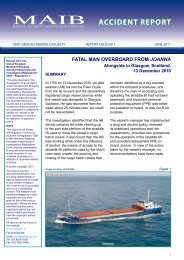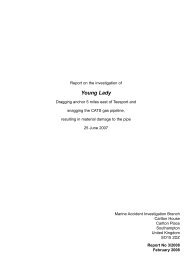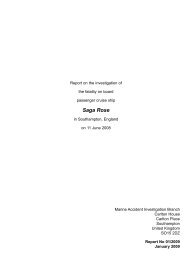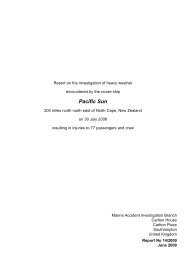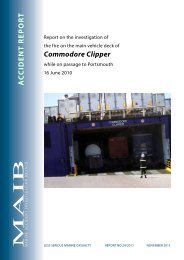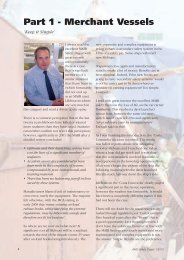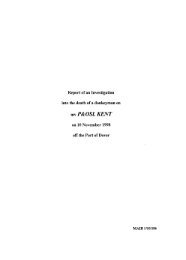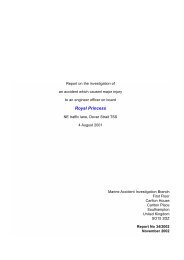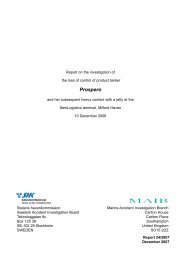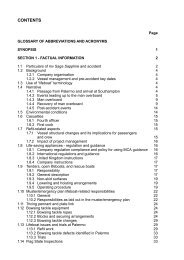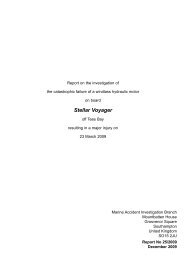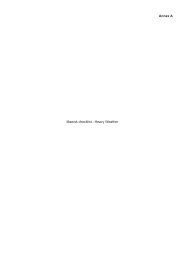Sichem Melbourne - Marine Accident Investigation Branch
Sichem Melbourne - Marine Accident Investigation Branch
Sichem Melbourne - Marine Accident Investigation Branch
You also want an ePaper? Increase the reach of your titles
YUMPU automatically turns print PDFs into web optimized ePapers that Google loves.
1.2<br />
1.2.1<br />
1.2.2<br />
NARRATIVE<br />
Much of the information in this report is derived from analysis of data retrieved from<br />
<strong>Sichem</strong> <strong>Melbourne</strong>’s Simplified Voyage Data Recorder (S-VDR).<br />
Environmental conditions<br />
• Dark<br />
•<br />
•<br />
•<br />
•<br />
•<br />
Wind: SW, Beaufort force 4<br />
Sea state, smooth<br />
Good visibility<br />
Spring tide +2 days; 1 hour before low water<br />
Approximately ½ to 1 knot easterly setting tidal stream, parallel to jetty 3.<br />
Events leading to the accident<br />
<strong>Sichem</strong> <strong>Melbourne</strong> completed the discharge of a cargo of gas oil at Coryton refinery<br />
during the evening of 25 February 2008. Arrangements were then made for the vessel<br />
to sail from the terminal’s No 3 berth, where she was lying port side to and heading<br />
downstream, for the NE Spit anchorage at the entrance to the River Thames.<br />
A PLA pilot boarded the ship at 1951 and proceeded to the bridge, where he met the<br />
master some 6 minutes later. During the initial discussions between the pilot and the<br />
master it was revealed that the latter thought that <strong>Sichem</strong> <strong>Melbourne</strong> was to proceed to<br />
the Sunk anchorage rather than the NE Spit anchorage. The discrepancy was clarified<br />
and it was agreed that the vessel would proceed to the NE Spit anchorage.<br />
A master and pilot exchange of information was carried out; this included pilot card<br />
items, draft confirmation, and questioning whether the vessel was similar to her sister<br />
ship, <strong>Sichem</strong> Edinburgh, which the pilot was familiar with. Both pilot and master had<br />
prepared passage plans covering the departure operation, however at no time were<br />
these compared or discussed. The pilot advised the master that, as an ebb tide was<br />
running, care would be needed when releasing the stern lines (just in case they were<br />
carried into the propeller by the tidal stream). The master asked which would be the<br />
last line to let go; the pilot advised it would be the forward spring.<br />
The chief officer explained to the pilot that the vessel’s automatic identification system<br />
(AIS) had suffered antennae damage on her inward voyage, and that a new one was<br />
now fitted, but that he was not sure if it was working properly. All pre-departure checks<br />
of engines and equipment were carried out, and the master informed the pilot that all<br />
was well and, specifically, that the bow thruster was working.<br />
As the vessel was facing downstream, port side to, the pilot’s intention was to come<br />
ahead on the forward springs and allow a substantial wedge of water to form between<br />
the ship’s stern and the jetty, putting the south westerly wind dead astern or fine on the<br />
port quarter. At this point he planned to let go the springs and bring the vessel astern<br />
into the channel. The plan to bring the vessel astern, however, was not discussed<br />
or shared with the master because the pilot felt it was self-explanatory. The master<br />
believed that, as there was only an hour of ebb tide to run, the stream would be fairly<br />
slack and that they would sail out ahead, away from the berth, on a course of 139˚, as<br />
3



